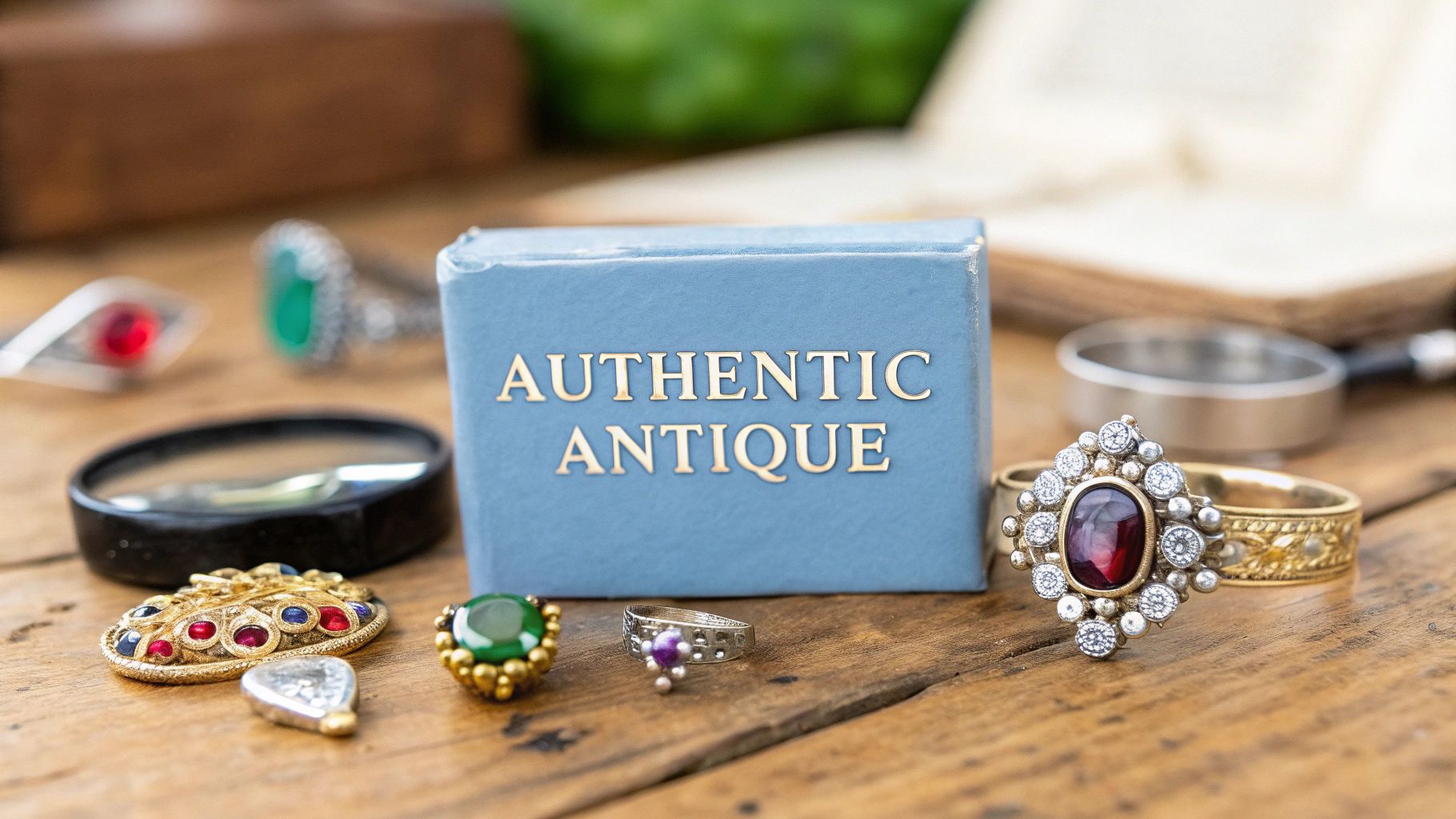There's something truly special about holding a piece of antique jewelry. It's more than just a beautiful object; it's a direct connection to the past. By definition, antique jewelry is any piece that is at least 100 years old. These aren't just accessories; they are tiny, wearable artifacts that whisper stories of forgotten eras through their unique craftsmanship and design.
For collectors, the value isn't just in the gold or gemstones. It’s in the rarity, the history, and the unmistakable character that modern, mass-produced pieces simply can't replicate.
The Magnetic Pull of Antique Jewelry
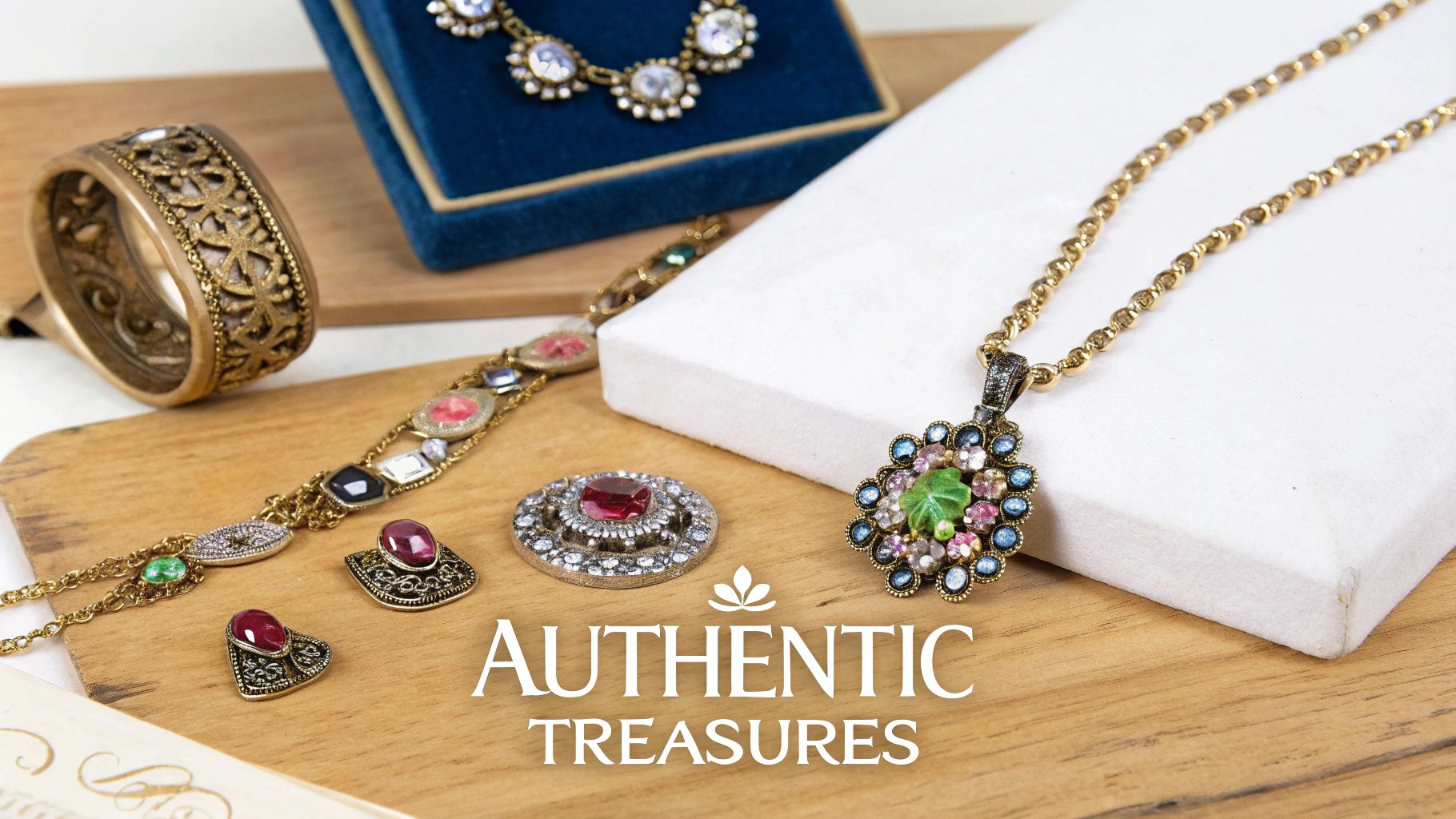
Imagine finding a ring that has seen a century of life or a locket that has been cherished through generations. Unlike anything you can buy new today, each antique piece has its own story, told through its design, materials, and the subtle marks of a life well-lived. This tangible link to history is what captivates so many of us, drawing us to items with real soul.
What was once a niche hobby has blossomed into a major market. The global estate and antique jewelry retail market hit a valuation of about $5.5 billion in 2024, with sales reaching across more than 195 countries. This isn't just a fleeting trend; it shows a deep, lasting interest from collectors who hunt for treasures in specialty shops and online marketplaces alike.
Why Collectors Choose Antique Pieces
Investing in antique jewelry is rarely a whim. It’s a deliberate choice, and for good reason. Here’s what sets these pieces apart for so many collectors:
- Lost Arts of Craftsmanship: Many antique pieces feature techniques you just don't see anymore. Think of the delicate, thread-like metalwork of filigree, intricate hand engraving, or old mine and rose-cut diamonds—all shaped by hand before modern machinery.
- A Truly Sustainable Choice: Buying antique is the ultimate form of recycling. You're giving a beautiful, pre-loved object a new chapter, which sidesteps the environmental and ethical issues tied to new mining and manufacturing.
- An Investment You Can Wear: A well-preserved piece from a coveted era—like Georgian, Victorian, or Art Deco—often holds its value and can even appreciate over time. It's both a stunning accessory and a smart financial move.
For many collectors, the appeal lies in wearing a piece of art that no one else has. It's a statement of individuality and an appreciation for a time when every detail was meticulously considered.
To really get into collecting, it helps to know the lingo. For example, understanding What Is Vintage Jewelry? is crucial, as the terms "antique" and "vintage" are often mixed up but mean different things. This guide is designed to give you the confidence to navigate the antique world, helping you turn the hunt for genuine treasures into a rewarding adventure. You'll soon learn how to spot a true historical artifact from a clever modern copy.
Decoding Hallmarks and Maker's Marks
Think of hallmarks as the secret language of antique jewelry. These tiny, intricate stamps are like a piece's birth certificate, telling a rich story about where it came from, the purity of its metal, the year it was made, and sometimes even the artisan who created it. For any serious collector, learning to read these marks is a foundational skill that turns a beautiful object into a historical document.
Inspecting these identifiers requires a bit of patience and the right tool. A jeweler's loupe, usually with 10x magnification, is your best friend here. It lets you get up close and personal with the tiny symbols that are often invisible to the naked eye. I always check the inside of a ring shank, the back of a brooch, or right near the clasp of a necklace—these are the most common hiding spots.
The Anatomy of a Hallmark
Hallmarks aren't just random etchings; they're part of a systematic code, especially in European jewelry. The British and French systems are famously detailed, offering a wealth of information if you know what you’re looking at.
A typical set of hallmarks might include several distinct stamps:
- Purity Mark: This tells you the metal's fineness. For instance, the iconic British lion passant has guaranteed sterling silver (92.5% pure) since the 16th century.
- Assay Office Mark: This reveals which city the piece was tested and stamped in. An anchor means it came out of Birmingham, while a leopard's head points to London.
- Date Letter: A specific letter of the alphabet, often in a unique font and shield shape, corresponds to a particular year.
- Maker's Mark: These are the initials or symbol of the workshop or jeweler behind the piece—their personal signature.
Learning these symbols is an exciting part of the hunt. For a deeper dive into this fascinating topic, you can explore our detailed guide on what hallmarks on silver mean, which really breaks down the symbols you're most likely to encounter.
What if There Are No Marks?
Finding a piece with no hallmarks can feel like hitting a brick wall, but don't automatically dismiss it as a fake. There are plenty of legitimate reasons why an authentic antique might be unmarked.
For instance, hallmarking wasn't legally required in the United States until the National Gold and Silver Stamping Act of 1906. This means a huge amount of American-made jewelry from the Victorian era and earlier will be completely unmarked. It’s a common scenario that just requires you to rely on other clues.
Keep in mind that marks can also be lost over time. Decades of wear can polish a hallmark into oblivion, or a resizing or repair could have inadvertently removed the very section of metal where the stamps were located.
When you come across an unmarked piece, your investigation simply shifts gears. You'll need to pay closer attention to construction techniques, the style of gemstone cuts, and the overall design motifs to place the item in its correct historical context. This is where a well-trained eye for period details becomes your most valuable asset.
This growing interest in historical pieces is part of a larger trend. The global antique market is projected to reach a value of $54.2 billion by 2025, with online antique sales growing annually by a staggering 18%. It shows a strong appetite for unique items with rich stories, making skills like hallmark identification more relevant than ever.
A Quick Guide to Common Antique Jewelry Hallmarks
To get you started, I've put together a quick reference table for some of the common marks you might find on your treasure-hunting journeys. Recognizing even a few of these can give you a fantastic launchpad for your research.
Quick Guide to Common Antique Jewelry Hallmarks
| Hallmark Symbol | Meaning | Associated Region/Country | Typical Era |
|---|---|---|---|
| Lion Passant | Sterling Silver (92.5%) | Great Britain | 1544 - Present |
| Eagle's Head | 18k Gold | France | 1838 - Present |
| Crown & 800 | 80% Silver Purity | Germany | Late 19th Century |
| '14K' or '585' | 14 Karat Gold | USA/Europe | Post-1906 (US) |
| Horse's Head | Silver (various purities) | France | 1838 - 1961 |
Of course, these symbols are just the tip of the iceberg in a vast and fascinating world. Each mark is a clue, and piecing them together to uncover a piece's history is one of the most rewarding parts of being a collector.
Evaluating Metals and Antique Gemstone Cuts
Hallmarks are a great place to start, but they aren't the whole story. To truly understand a piece of antique jewelry, you have to learn to read the materials themselves. The type of metal and the way the gems are cut can often tell you more about a piece's age and history than a faint, worn-down stamp ever could. This is the skill that really separates a casual buyer from a serious collector.
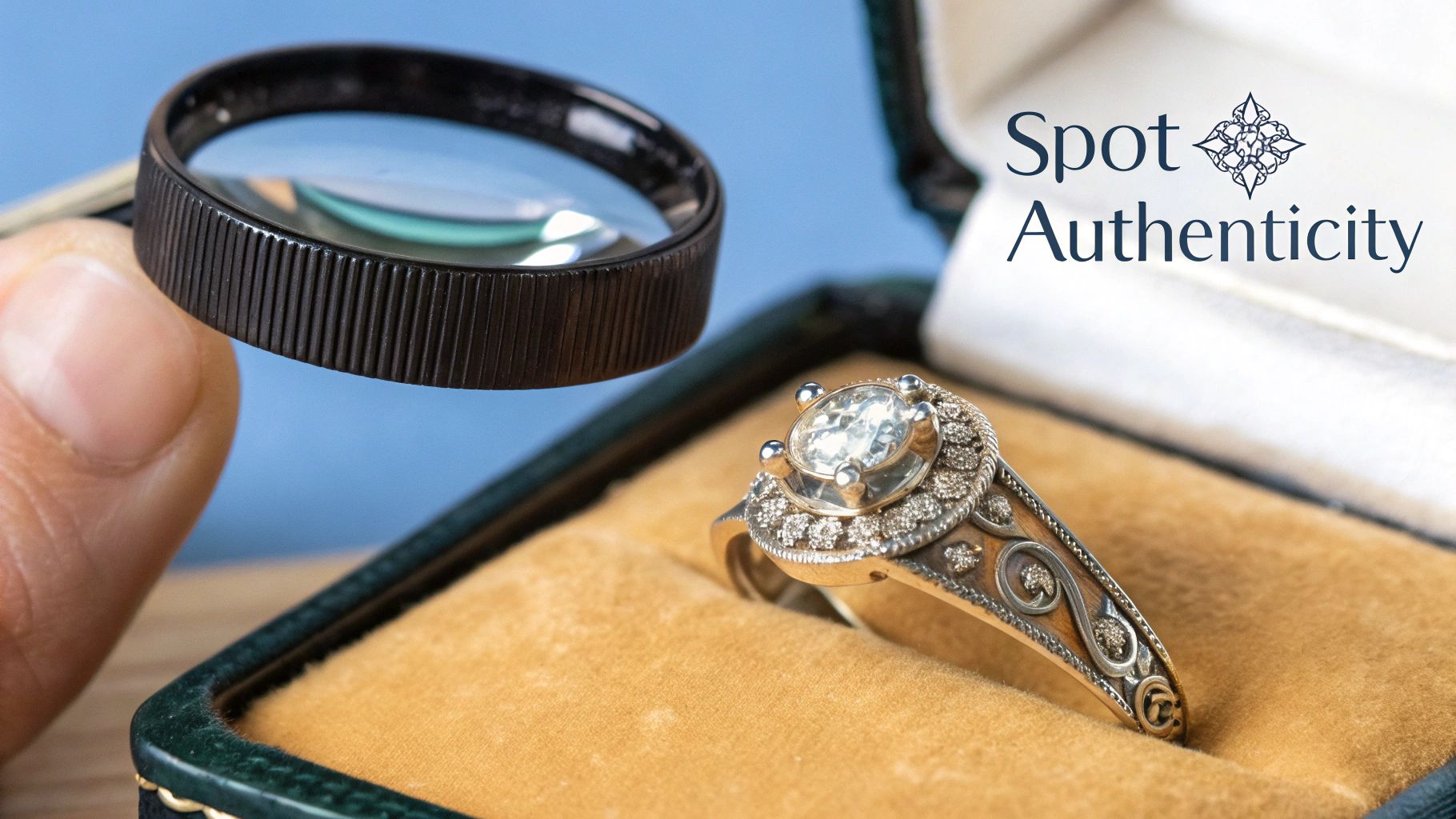
Think of it this way: different eras had their own favorite materials. For example, platinum didn't really take off in jewelry until the early 20th century. If you stumble upon a locket with a distinctly Victorian design but it's made of platinum, your alarm bells should be ringing. It's almost certainly a modern reproduction.
Reading the Story in the Metal
There's a certain character to antique metals that modern techniques just can't replicate. Over time, they develop a unique patina—a soft, warm glow that comes from decades of being worn and exposed to the air. This isn't just dirt or tarnish; it's a beautiful, gentle aging process that can't be faked.
For instance, jewelers in the Georgian era often fused gold over a silver base. This technique gave them the bright white of silver for setting diamonds while the gold backing kept the silver from tarnishing and rubbing off on clothing. Spotting this dual-metal construction is a fantastic clue that you're looking at a genuinely early piece.
Victorian jewelers had their own tricks, too. They loved using Pinchbeck, a clever alloy of copper and zinc that looked just like gold, allowing them to create stunning pieces without the hefty price tag. A real Pinchbeck item has a distinctive warm, brassy hue that's quite different from any modern gold plating you'll see.
The Distinct Personalities of Antique Gemstone Cuts
Long before we had machines for precision faceting, every single gemstone was cut and polished by hand. The goal wasn't to achieve perfect mathematical symmetry like we see today. Instead, artisans focused on maximizing a stone's glow and sparkle by candlelight. Learning to spot these old cuts is one of the most reliable methods for dating a piece.
You'll run into these three iconic antique diamond cuts all the time:
- The Rose Cut: This cut goes all the way back to the 16th century and was a favorite through the Georgian period. It has a flat bottom and a dome-shaped top covered in triangular facets. It was designed to glitter softly in low light, giving it a romantic, subtle sparkle.
- The Old Mine Cut: Popular in the 18th and 19th centuries, this was the direct ancestor of the modern brilliant cut. These are chunky, cushion-shaped stones with a high crown, a small top facet (the table), and a noticeably large facet at the bottom (the culet). They possess a deep, soulful fire that many collectors absolutely love.
- The Old European Cut: This cut emerged in the late Victorian and Edwardian periods and is the immediate forerunner to today's round brilliant. It's rounder than an Old Mine Cut but still has that high crown, small table, and open culet. It was masterfully designed to catch and throw back the warm, fiery light from gas lamps.
Here's a critical tip to remember: The modern brilliant-cut diamond wasn't the standard until the mid-20th century. If you find a perfectly proportioned brilliant diamond in a setting that's supposedly from the Art Deco era or earlier, the stone is almost certainly a later replacement.
Distinguishing Authentic Wear from Fakes
Finally, you have to train your eye to tell the difference between genuine age and a deliberate fake. Real antique jewelry shows wear in places that make sense.
Look for a subtle thinning on the back of a ring's shank where it's rubbed against a finger for a hundred years. You should see tiny, faint scratches and softly rounded edges on the facets from decades of gentle contact. These are the beautiful battle scars of a piece that has been truly loved and worn.
On the other hand, be very suspicious of pieces with harsh, uniform scratches all over or dings in protected nooks and crannies. This often points to "distressing," a technique where someone tries to artificially age a new piece to pass it off as an antique. The wear patterns on a genuine antique will always tell a logical story.
Matching Styles to Historical Eras
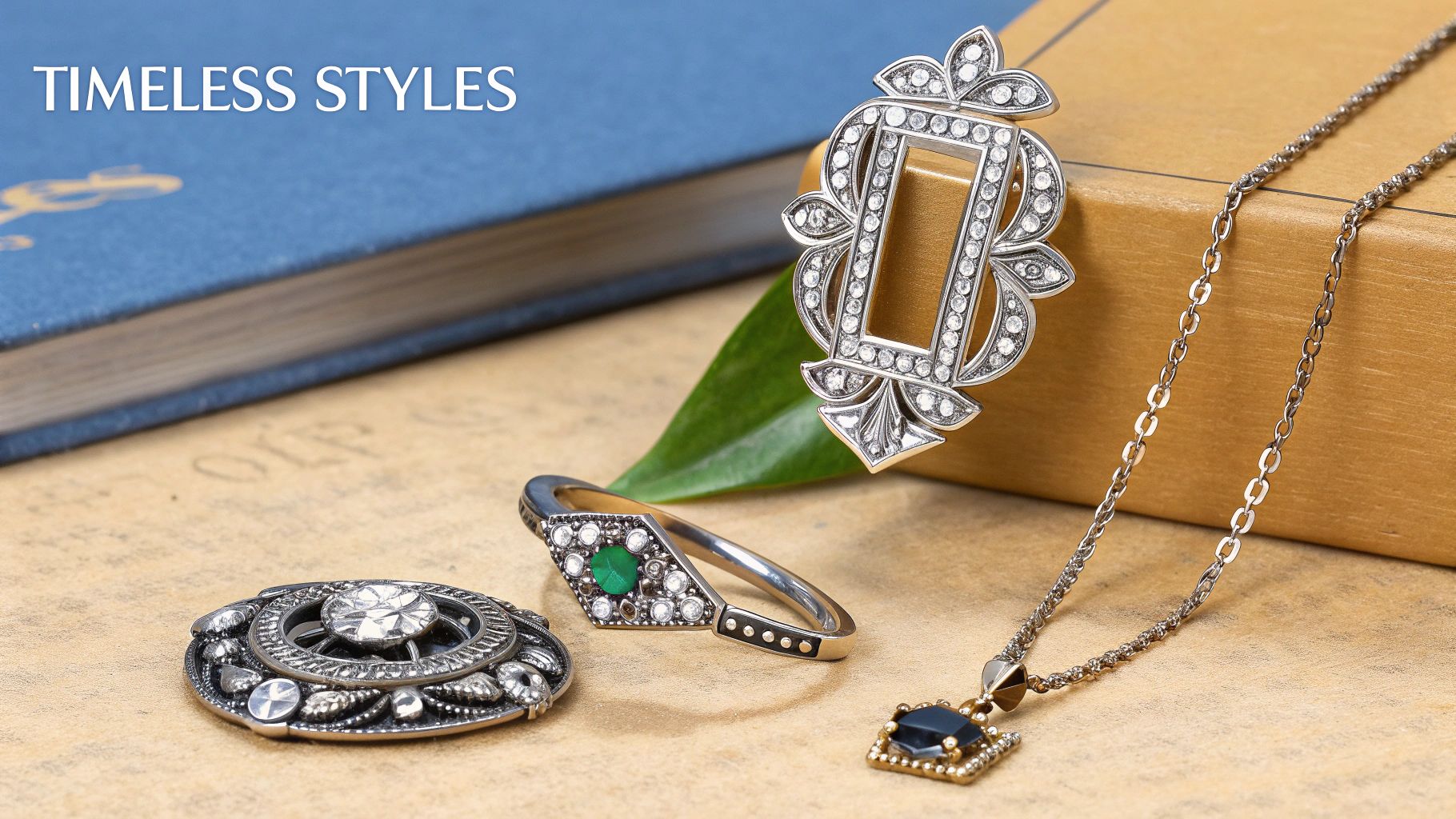
When you hold a truly authentic piece of antique jewelry, it just feels right for its time. Every curve, motif, and gemstone choice tells a story, linking it to a specific moment in history. Honestly, learning to read these clues is one of the most powerful skills you can develop for authentication.
This is your best defense against fakes and "married" pieces—those items cobbled together from different eras to seem more valuable. Spotting an anachronism, like a modern clasp on what's supposed to be a Victorian necklace, can save you from a very costly mistake. Let’s walk through the defining styles of the major jewelry eras.
The Romantic and Sentimental Victorian Era (1837-1901)
Queen Victoria’s reign was long and saw incredible change, and the jewelry styles evolved right along with it. We usually break the era into three distinct periods, each with its own personality.
- Early Victorian (Romantic Period): This was all about the young queen’s love for Prince Albert. Jewelry was deeply sentimental and pulled from nature, with delicate floral engravings, snakes symbolizing eternal love, and incredibly intricate metalwork.
- Mid-Victorian (Grand Period): After Prince Albert's death in 1861, mourning jewelry took center stage. Pieces from this time are heavier and more somber, often featuring dark materials like jet, onyx, and vulcanite. You’ll frequently see them accented with seed pearls, which were meant to represent tears.
- Late Victorian (Aesthetic Period): As the era wound down, jewelry designs became lighter and more whimsical. Motifs like stars, crescents, and insects became popular. Plus, the discovery of diamonds in South Africa led to an absolute explosion of dazzling diamond-set pieces.
A classic tell for any Victorian piece is its focus on sentiment. Think of lockets designed to hold a curl of hair or acrostic jewelry where the first letter of each gemstone spells out a secret word like "DEAREST" (Diamond, Emerald, Amethyst, Ruby, Emerald, Sapphire, Topaz).
The Ethereal Art Nouveau Period (Circa 1890-1910)
Art Nouveau was a direct reaction to what many saw as the stiffness of Victorian design. This movement was all about flowing, organic forms, asymmetry, and a deep connection to the natural world. To authenticate a piece from this period, you have to look for its signature, dreamlike motifs.
Art Nouveau jewelers were true artists, drawing inspiration from fantastical interpretations of nature. Key elements to look for include:
- Flowing Lines: Think whiplash curves, elegant swirls, and lines that seem to be in constant motion.
- Nature Motifs: Dragonflies, butterflies, orchids, and graceful swans were all incredibly common subjects.
- Feminine Forms: The female figure, often with long, flowing hair, was a central and recurring theme.
One of the most unique aspects of Art Nouveau is its innovative use of materials. Jewelers like René Lalique chose materials for their artistic potential, not just their price tag. This is why you’ll find breathtaking pieces made with horn, ivory, and vibrant plique-à-jour enamel, which creates a stunning stained-glass effect.
The Delicate Edwardian Era (1901-1915)
Also known as the "Belle Époque," the Edwardian era was a time of unparalleled elegance and luxury. The real game-changer here was platinum. New metalworking techniques made it possible to use platinum extensively, and its strength allowed jewelers to create intricate, lace-like designs that were simply impossible with gold alone.
To spot an authentic Edwardian piece, look for its trademark lightness and airiness. The style is often called "garland style" because of its frequent use of swags, wreaths, and bows. Platinum was used to create delicate yet surprisingly strong settings, often featuring millegrain detailing—those tiny beads of metal along the edges that add a soft, glittering texture. This painstaking detail is a hallmark of the era's fine craftsmanship.
The Bold and Geometric Art Deco Period (1920-1935)
The Roaring Twenties brought a dramatic shift away from the delicate styles that came before. Inspired by the machine age, modern art, and major archaeological discoveries, Art Deco jewelry is all about bold geometry, sharp lines, and vibrant color. It’s a confident, glamorous style that perfectly captures the spirit of the age.
Key characteristics of Art Deco design are hard to miss once you know what to look for:
- Strong Geometric Shapes: Circles, squares, triangles, and rectangles were used in symmetrical, repeating patterns.
- Sharp Color Contrasts: Jewelers loved pairing bright gemstones like emeralds and sapphires with the stark contrast of black onyx or brilliant white diamonds.
- New Gemstone Cuts: Calibré-cut gems—stones custom-cut to fit perfectly against each other in a mosaic-like design—are a true signature of the period.
Sometimes, the most obvious giveaways are the little things, like the hardware. For instance, the spring ring clasp was common in the early 20th century, while the lobster clasp is a much more recent invention. Knowing these small but crucial details is key, and you can learn more by exploring the different types of vintage and antique necklace clasps in our detailed guide.
This renewed appreciation for historical design isn't just a niche interest, either. Millennials and Gen Z are increasingly drawn to the antique market, fueling a projected annual growth rate of 4-6% in luxury jewelry sales between 2025 and 2027. They're often choosing antique pieces for their sustainability, unique character, and lasting value. You can discover more insights about this demographic shift and its impact on the jewelry market at Observer.com.
How to Buy and Appraise Antique Jewelry
So, you’ve learned to spot the hallmarks, identify materials, and recognize historical styles. Now for the exciting part: stepping into the marketplace to find your own piece of history. Whether you're navigating a chaotic flea market, a sophisticated auction house, or just scrolling through online listings, buying antique jewelry is a thrilling hunt.
But it’s not just about falling in love with a beautiful design. A smart buyer knows how to vet the seller, ask the right questions, and, most importantly, when to walk away. Your confidence will build with every piece you handle and every dealer you talk to.
Vetting Sellers and Asking the Right Questions
Honestly, the seller is just as important as the jewelry. A reputable dealer is your best guide, someone who provides accurate information and stands by their collection. Don't be shy about doing a little detective work on their background.
Before you even consider a purchase, do some quick research. Look for established dealers who are members of respected trade organizations like the National Antique & Art Dealers Association of America (NAADAA). A long history of positive reviews and sales is also a great sign.
Once a piece catches your eye, it's time to start a conversation. Be direct and specific with your questions.
- Dig into its history: Ask about the piece’s provenance—its documented history of ownership. While a full paper trail is rare for most antiques, a good dealer can usually share where they got it and any story that came with it.
- Check for repairs or alterations: Has the ring been resized? Is that a replacement stone? An honest seller will openly disclose any and all modifications. This is critical for understanding the piece's authenticity and true value.
- Confirm the return policy: Any reputable dealer will have a clear, fair return policy. If they hesitate or don't offer one, that's a huge red flag. It’s best to just walk away.
A seller's willingness to patiently answer all your questions is one of the best signs of their integrity. If they seem cagey, annoyed, or dismissive, trust your gut and move on.
The Critical Role of a Professional Appraisal
After you've brought a special piece home, your next step should be getting it professionally appraised. This isn't just for curiosity's sake; it's a crucial step for getting insurance and confirming the value of your new investment. An appraisal is a formal document that details everything about your item and assigns it a monetary worth.
But here’s the thing: not all appraisals are created equal. You need to find a certified gemologist who truly specializes in antique and period jewelry. These experts have the trained eye to identify old-mine gemstone cuts, recognize period-specific construction techniques, and spot the subtle details a general appraiser would likely miss.
When learning how to buy and appraise antique jewelry, it's essential to protect your investment by understanding common 'making charge' scams in the jewelry business. Knowing these tricks helps you avoid overpaying. For a broader look at valuation, our guide on how to appraise antiques has some great additional tips.
Understanding Different Types of Value
An appraiser will usually give you a couple of different value figures, and it's important to know what they mean. They each serve a very different purpose.
| Valuation Type | Purpose | Typical Amount |
|---|---|---|
| Insurance Replacement Value | To replace the item with a similar one if it's lost, stolen, or damaged. | This is the highest number, reflecting the full retail cost to buy a comparable piece today. |
| Fair Market Value | To determine a reasonable price for a sale between a willing buyer and seller. | This value is usually lower than the insurance value and shows what the item might realistically sell for on the current market. |
Understanding this distinction is key. Seeing that high insurance value is exciting, but the fair market value gives you a much more practical idea of what you could get if you ever decide to sell. Always ask your appraiser to clarify which values they've included in their report. This knowledge empowers you to protect your investment and buy your next piece of authentic antique jewelry with total confidence.
Common Questions About Antique Jewelry
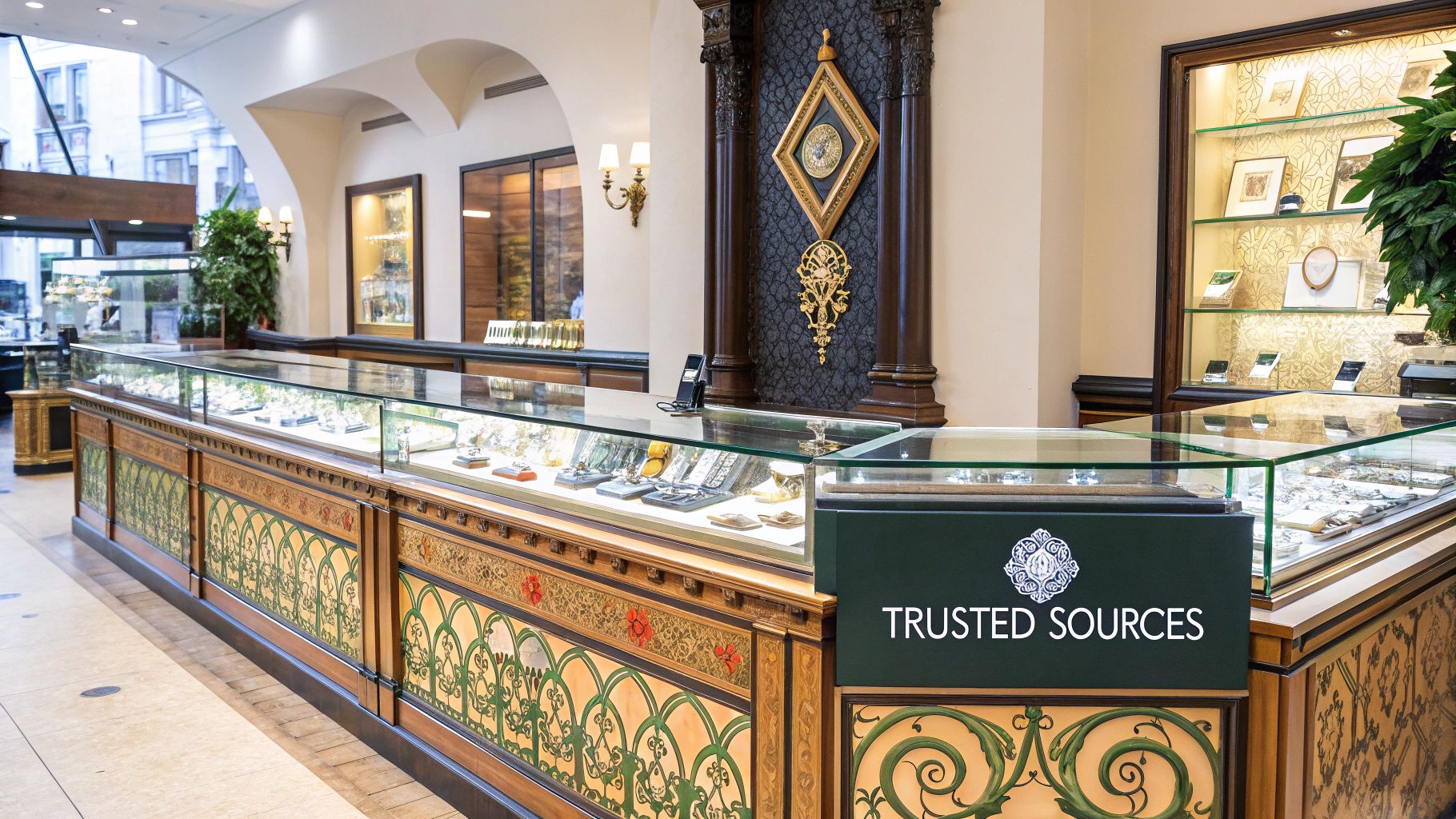
As you start exploring the fascinating world of antique jewelry, you're bound to have questions. That's a great sign—it means you're starting to think like a real collector and developing a sharp eye.
Let's dive into some of the most common questions I hear from both beginners and seasoned pros. Getting these answers straight will give you the confidence you need to talk to dealers, size up a potential buy, and take better care of the treasures you already own.
What Is the Difference Between Antique and Vintage Jewelry?
This is easily the most common question out there. People use "antique" and "vintage" interchangeably all the time, but in the world of collecting, the distinction is clear and really important.
Here’s the breakdown:
- Antique Jewelry: A piece must be at least 100 years old. This is the official industry standard, no ifs, ands, or buts. So, a ring made in 1920 is now officially an antique.
- Vintage Jewelry: This term usually applies to items between 20 and 99 years old. That chunky cocktail ring from the 1980s? It’s a perfect example of vintage.
Understanding this timeline is your first step in any evaluation. It’s fundamental to dating a piece, describing it accurately, and figuring out its true value.
Does No Hallmark Mean My Jewelry Is Fake?
Not necessarily! While finding a crisp set of hallmarks is like hitting the jackpot, the lack of them doesn't automatically mean you're looking at a fake. There are plenty of perfectly legitimate reasons a piece might be unmarked.
For starters, hallmarking laws have changed a lot over time and varied from country to country. In the U.S., there was no federal requirement to mark gold or silver for purity before the National Gold and Silver Stamping Act of 1906. That means a huge amount of American jewelry from the Victorian era and earlier is completely unmarked.
It's also worth remembering that decades of loving wear can literally polish a faint mark right off a piece. A resizing or a clumsy repair could also easily remove the exact spot where a stamp was located. When the marks are gone, you just have to lean more heavily on the other clues—construction techniques, gemstone cuts, and design style—to solve the puzzle.
How Should I Clean My Antique Jewelry?
When it comes to cleaning, the absolute golden rule is to be gentle. These pieces are often far more delicate than modern jewelry, and a heavy hand can cause permanent damage.
Never, ever use ultrasonic cleaners or harsh chemical soaks. These can be disastrous, shattering fragile stones like opals and emeralds or ruining delicate enamel work and the foil backings that give old-cut stones their unique glow.
For most gold and platinum jewelry set with hard stones like diamonds, a simple, safe approach is best:
- Grab a very soft baby toothbrush.
- Use a tiny drop of mild dish soap and some lukewarm water.
- Gently brush the piece, getting into the nooks and crannies.
- Rinse it well and pat it dry with a soft, lint-free cloth.
If you have something that's particularly fragile, valuable, or features sensitive materials like pearls or ivory, don't risk it. Your best bet is always to consult a professional jeweler who specializes in antique pieces. Their expertise is the best insurance policy you can have.
Feeling inspired to uncover the stories behind your own treasures? With Curio, you can identify antiques, get appraisals, and learn their history with just a photo. Download the app and turn your curiosity into expertise. Find out more at https://www.curio.app.
